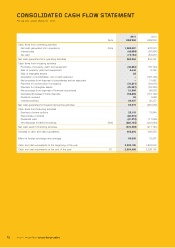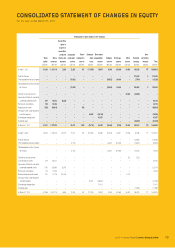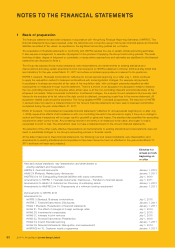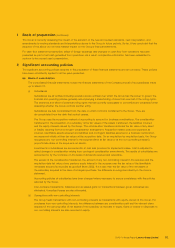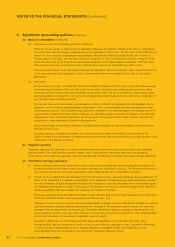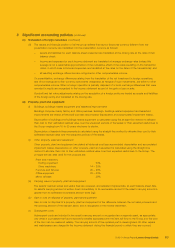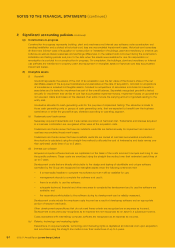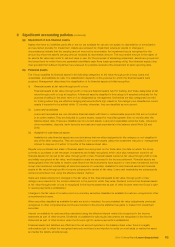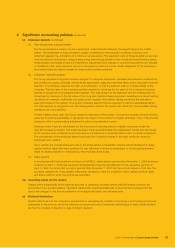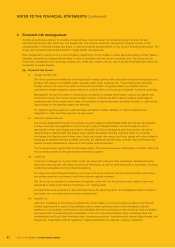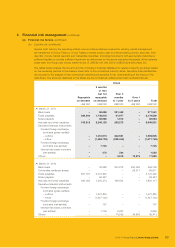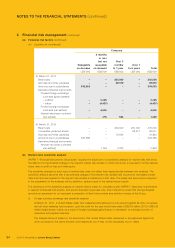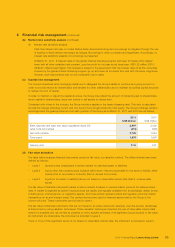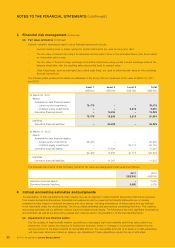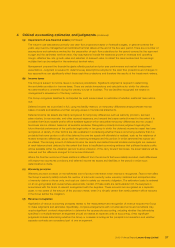Lenovo 2011 Annual Report Download - page 84
Download and view the complete annual report
Please find page 84 of the 2011 Lenovo annual report below. You can navigate through the pages in the report by either clicking on the pages listed below, or by using the keyword search tool below to find specific information within the annual report.
2010/11 Annual Report Lenovo Group Limited 87
2 Significant accounting policies (continued)
(j) Derivative financial instruments and hedging activities
Derivatives are initially recognized at fair value on the date a derivative contract is entered into and are subsequently
re-measured at their fair value. The method of recognizing the resulting gain or loss depends on whether the derivative
is designated as a hedging instrument, and if so, the nature of the item being hedged. The Group designates certain
derivatives as either: (1) hedges of the fair value of recognized assets or liabilities or a firm commitment (fair value
hedge) or (2) hedges of highly probable forecast transactions (cash flow hedges).
The Group documents at the inception of the transaction the relationship between hedging instruments and hedged
items, as well as its risk management objectives and strategy for undertaking various hedging transactions. The Group
also documents its assessment, both at hedge inception and on an ongoing basis, of whether the derivatives that are
used in hedging transactions are highly effective in offsetting changes in fair values or cash flows of hedged items.
The full fair value of a hedging derivative is classified as a non-current asset or liability when the remaining hedged item
is more than 12 months, and as a current asset or liability when the remaining maturity of the hedged item is less than
12 months. Trading derivatives are classified as a current asset or liability.
(i) Fair value hedge
Changes in the fair value of derivatives that are designated and qualified as fair value hedges are recorded in the
income statement, together with any changes in the fair value of the hedged asset or liability that are attributable
to the hedged risk.
(ii) Cash flow hedge
The effective portion of changes in the fair value of derivatives that are designated and qualify as cash flow hedges
is recognized in other comprehensive income. The gain or loss relating to the ineffective portion is recognized
immediately in the income statement.
Amounts accumulated in equity are reclassified to the income statement in the periods when the hedged item
affects profit or loss (for example, when the forecast sale or purchase that is hedged takes place). The gain or loss
relating to the effective portion of interest rate swaps hedging variable rate borrowings is recognized in the income
statement within ‘finance costs’. The gain or loss relating to the ineffective portion is recognized in the income
statement within ‘other operating income/(expenses) – net’. However, when the forecast transaction that is hedged
results in the recognition of a non-financial asset (for example, inventory), the gains and losses previously deferred
in equity are transferred from equity through other comprehensive income and included in the initial measurement
of the cost of the asset.
When a hedging instrument expires or is sold, or when a hedge no longer meets the criteria for hedge accounting,
any cumulative gain or loss existing in equity at that time remains in equity and is recognized when the forecast
transaction is ultimately recognized in the income statement. When a forecast transaction is no longer expected to
occur, the cumulative gain or loss that was reported in equity is immediately transferred to the income statement.
(iii) Derivatives that do not qualify for hedge accounting
Certain derivative instruments do not qualify for hedge accounting. Changes in the fair value of any derivative
instruments that do not qualify for hedge accounting are recognized immediately in the income statement.
(k) Inventories
Inventories are stated at the lower of cost and net realizable value. Cost is determined on a weighted average basis, and
in the case of work-in-progress and finished goods (except for trading products), cost comprises direct materials, direct
labour and an attributable proportion of production overheads. For trading products, cost represents invoiced value on
purchases, less purchase returns and discounts. Net realizable value is determined on the basis of anticipated sales
proceeds less estimated selling expenses.
(l) Trade and other receivables
Trade receivables are amounts due from customers for merchandise sold or services performed in the ordinary course
of business. Majority of other receivables are amounts due from subcontractors for part components sold in the ordinary
course of business. If collection of trade and other receivables is expected in one year or less (or in the normal operating
cycle of the business if longer), they are classified as current assets. If not, they are presented as non-current assets.
Trade and other receivables are recognized initially at fair value and subsequently measured at amortized cost using the
effective interest method, less provision for impairment.



